
This post is just for fun. A week ago, a fellow langa-(w)riter asked which Singh was really King? As the buzz for the upcoming “Singh is Kinng” movie continues, many had heard the news that Snoop Dogg had donned a pagh for a promotion with Akshay Kumar.
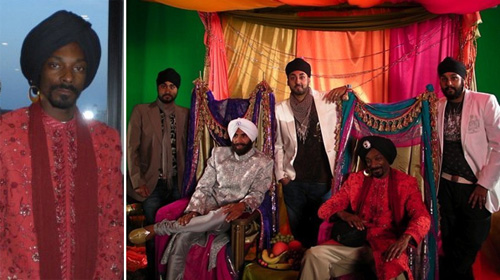 While many that were looking for Snoop Singh ended up finding this convert, my guess guess was that the people had something else in mind. Many people have emailed us asking if we had seen the picture of Snoop Dogg (for me he will always be Snoop Doggy Dogg) with the pagh. To make it easier for all of you internet hunters, here is the picture of Snoop with the turban, sitting like a king with Akshay.
While many that were looking for Snoop Singh ended up finding this convert, my guess guess was that the people had something else in mind. Many people have emailed us asking if we had seen the picture of Snoop Dogg (for me he will always be Snoop Doggy Dogg) with the pagh. To make it easier for all of you internet hunters, here is the picture of Snoop with the turban, sitting like a king with Akshay.
For a link explaining how Snoop came to don the turban in Chicago, you can read a link here.
Sources revealed that the rapper dressed exactly like a Sikh with a turban on his head while recording the track. They even said that the rapper was to have his own crew and clothes, but Akshay convinced him to wear a turban. [link]
This recent article about a granthi in Leeds suing for unfair dismissal brought me back to the topic of granthis in general. Given Sikhi’s very clear edict AGAINST the institution of a clergy, I always found it distressing to see whole gurdwaras managed and oragnized by hired granthis. If a sangat (or gurdwara) was too big to function on seva, hadn’t it possibly grown beyond its equilibrium? I always felt uneasy about high-profile (and high cost!) guest granthis, specialized sermons, and other performance-based methods in the gurdwara. Not to mention really distressed that lecturing and sermonizing often extended services and, in my opinion, often drew away from time spent in reflection around kirtan.
It also seems, to me, that the formal establishment (and acceptance) of granthis as “ordained” disciples of Sikhi encourages the creation of a laity. In theory, shouldn’t all Sikhs be capable of organizing and leading their own services? Shouldn’t we encourage everyone to achieve the literacy and familiarity necessary to comfortably participate in shabad kirtan, ardaas, and the basic requirements of langar? In the U.S., we absolutely do not provide sufficient resources to ensure this across sangats (some sangats are notable exceptions, e.g., the Beavercreek, OH, sangat, which is completely volunteer-run with no granthis, despite a population of <50 Sikhs). If we wanted to help mobilize Sikhs to be able to run their own gurdwaras, what kind of resources would we need to provide?
I understand that once we employ granthis there’s an implicit contract and deferral to their “wisdom,” but to what extent are we eroding our own personal understanding and potential for discussion, debate, and growth within Sikhi and within our own sangats? I have heard some liken granthis to spiritual guides; I would argue, however, that SGGS Ji is our guide, the Rehit Maryada our manual, and the sangat our laboratory for refining our understanding.
A recent French decision brings debates about multiculturalism and accommodation back into focus. France’s highest administrative court prevented the wife of a French national and mother of 3 French- born children from obtaining French citizenship based purely on her wearing of a niqab– for “insufficient assimilation” into France:
…last month, France’s highest administrative court upheld a decision to deny citizenship to Ms. Silmi, 32, on the ground that her “radical” practice of Islam was incompatible with French values like equality of the sexes. [link]
The decision received support from some French-Muslim officials who do not support women’s wearing of niqabs.
niqabs.
The ruling on Ms. Silmi has received almost unequivocal support across the political spectrum, including among many Muslims. Fadela Amara, the French minister for urban affairs, called Ms. Silmi’s niqab “a prison” and a “straitjacket.” “It is not a religious insignia but the insignia of a totalitarian political project that promotes inequality between the sexes and is totally lacking in democracy,” Ms. Amara, herself a practicing Muslim of Algerian descent, told the newspaper Le Parisien in an interview published Wednesday. [link]
There are major differences between the niqab and Sikh religious dress. The objection to the niqab that it’s incompatible with the French value of equality of the sexes doesn’t carry over to Sikh dress. The dastaar or pag doesn’t pose the same dilemma as both men and women may wear it, and it is not seen as an inhibition on gender equality generally.
Guest Blogged by Mewa Singh.
A bit late, but every bit warranted.
Let me begin. I am a HUGE Rabbi Shergill fan. I went to a Dharmendra/Sunny Deol “concert” two years ago (why they are called ‘concerts’ I have no clue) and Rabbi Shergill was performing. I think I was the ONLY 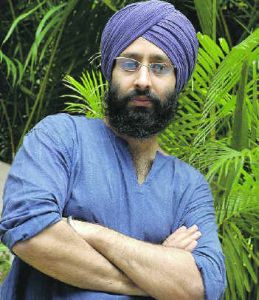 Rabbi Shergill fan in the audience and in certain parts of California that isn’t too surprising. Although my friends and family made fun of me, they were kind compared to the rest of the audience. The audience yelled their ever-so-kind “Eh ki bakwas hai? Bhangra Ga!” (What is this crap? Sing Bhangra!) and began to boo him off the stage in the middle of his ‘Chhalla’ performance. Although I love my hometown, sometimes we are stupid.
Rabbi Shergill fan in the audience and in certain parts of California that isn’t too surprising. Although my friends and family made fun of me, they were kind compared to the rest of the audience. The audience yelled their ever-so-kind “Eh ki bakwas hai? Bhangra Ga!” (What is this crap? Sing Bhangra!) and began to boo him off the stage in the middle of his ‘Chhalla’ performance. Although I love my hometown, sometimes we are stupid.
Rabbi’s first self-titled album played in my car for months straight. Despite the ridicule of all of my friends, I was mesmerized by his brilliance. In my own version of ‘elitism,’ I just thought they couldn’t “understand” Rabbi. How brilliant was this contemporary music artist not only recreating but reinterpreting classic poetic metrics and musical composition forms with current political and social content. While his “Bulla Ke Jana” garnered critical attention and success, for me his “Jugni” with its political content, “Totia Manmotia” for its social charge and reinterpretation of a whimsical Mughal-period popular dialogue between parrots, and the thrilling rendering of his Shiv Kumar Batalvi in “Ishtihar” sent tingles down one’s spine. Sepia Mutiny’s Amardeep criticized Rabbi’s earlier supposed “Sufi/Sikh spiritualist” image, however, such a reading could only be made by one that had never listened past “Bulla Ke Jana.”
Although three years in the making, Rabbi returns with a new album Avengi Ja Nahin (the website includes song samples, videos, and even lyrics). The album has 9 tracks and I have yet to listen to all of them. The cover song “Avengi Ja Nahin” is a nice love song. The other song to gain much attention is his “Biqlis” that provides a voice to the many voices lost during the anti-Muslim government-sponsored pogroms in Gujarat in 2002. The song is stirring, being both patriotic but critical.
Punjabis can argue whether Gurdas Mann’s classic Chhalla from the movie Laung Da Lishkara is the best or Rabbi’s new rendering. For my vote, I just want to add that Rabbi is on the world stage singing Punjabi (in his Jugni invoking that the solution to today’s problems was to invoke the Guru’s name), while during the 1980s and early 1990s Gurdas Mann went to Bombay and record plenty of Hindi content.
However, especially important for a Sikh audience would be a discussion on his song “Pagri Sambhaal Jatta.”
Over the past few years the website Sikhitothemax.com has become one of the premier tools for English-fluent Sikh youth to access their Guru Granth Sahib. While STTM has problems that can be addressed at another time, it is important to realize the effect that this tool has had. 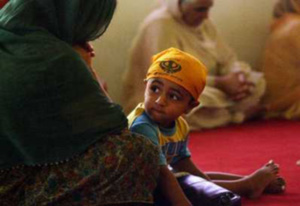 Many Gurdwaras throughout the world have added STTM translations as part of their regular programs and the projection system in the Gurdwara is fast becoming the norm.
Many Gurdwaras throughout the world have added STTM translations as part of their regular programs and the projection system in the Gurdwara is fast becoming the norm.
But is it enough?
In a recent article in the Fresno Bee, reporter Vanessa Colon looks at the question of “losing tradition in translation.”
Colon interviews a number of Central Valley Sikhs and finds that the Sikh youth are often not engaged with their Gurdwara. Although there a number of reasons, she delves into the question of language first and foremost. Some local Fresno Sikhs blamed the Sikh youth for not learning enough Punjabi. However, I see that this approach has problematic for there are now a number of Punjabi/Khalsa schools in California and beyond. However, instruction one day a week for an hour will not ever provide a sufficient language base for one to understand Gurbani.
There’s been some controversy over the upcoming film, ‘Singh is Kinng,’ [sic] starring Akshay Kumar and a host of other Indian actors I don’t know, scheduled to hit theatres on August 8th.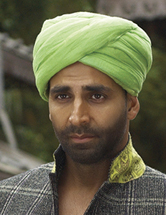
Singh is Kinng is a story about Happy Singh, a Punjabi Sikh. He is very mischievous and gets involved in a number of disastrous situations, so the villagers plan to send him to Australia to bring back his fellow villager, Lucky Singh. It is then revealed that Lucky is a underworld Don in Australia. Then, in a accident, Happy saves Lucky but still Lucky becomes paralysed. Hence, Happy becomes the new King of the Australian Underworld. [link]
For those who haven’t been following the controversy- the problem revolved around the portrayal of Sikhs in the movie (physical appearance as well as particular scenes). I haven’t seen much information on the scenes, but am assuming that they involve explicit conduct that was found offensive to screeners’ moral sensibilities. As for the the physical appearance, I can’t exactly blame critics after seeing what “Singhs” look like in the movie… (see picture on right). Um… I don’t know who tied his pag or what it’s made of or what type of fashion statement the movie is trying to make, but I don’t think any Singh I know would ever wear that.
Earlier in the month, an East Panjabi newspaper editor, Baljit Brar, posed the possibility that Pakistan stood to earn up to $500 million per year by promoting Sikh tourism.
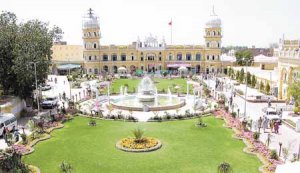 Brar suggests that since the airport in Lahore is more convenient and is better maintained than that in Amritsar, with better border mobility the Lahore airport could be the airport of choice for diasporic Sikhs. Many Sikhs have bought into the ‘Romance that is Panjabiyat,’ including at-times the present langa(w)r-iter. While Brar’s numbers may be grossly optimistic, I do believe that many Sikhs would love to take advantage of new tourism and travel opportunities.
Brar suggests that since the airport in Lahore is more convenient and is better maintained than that in Amritsar, with better border mobility the Lahore airport could be the airport of choice for diasporic Sikhs. Many Sikhs have bought into the ‘Romance that is Panjabiyat,’ including at-times the present langa(w)r-iter. While Brar’s numbers may be grossly optimistic, I do believe that many Sikhs would love to take advantage of new tourism and travel opportunities.
Many Sikhs left West Panjabi villages and cities in their stead in 1947. Another langa(w)r-iter had commented on the traumas of Partition. The opportunity to revisit one ancestral home may be part of the process in healing old wounds.
Brar makes a number of suggestions. In a world where economics flows across borders, new opportunities may avail themselves to the Sikhs to increase the prosperity of Panjab. One hopes governments can help create an environment where greater flows are possible. I definitely have longed to visit West Panjab. What about you? Is something like this feasible?
In Ludhiana, a 29 year old woman, Hardeep Kaur, was just found dead at her in-laws house. Her brother, Harpreet Singh, informed the police that she had been frequently harassed by her in-laws about a dowry, and he alleged that the in-laws murdered her. According to Harpreet, Hardeep had just recently returned to her in-laws house under the assurance that she wouldn’t be harassed again. [link]
Considering the circumstances, it seems the assurances were false. Hardeep leaves behind a 7 year old son and a 1 and 1/2 year old daughter.
and a 1 and 1/2 year old daughter.
According to sources, Hardeep’s brother Harpreet Singh, a resident of Vishkarma colony under the Shimlapuri police station, received a call from Hira Singh’s brother-in-law Karamjit Singh informing that Hardeep had died under mysterious circumstances. He said when he went to his sister’s house, he found the house empty and the body of Hardeep was lying in a room. [link]
No arrest has been made yet, and Hardeep’s body has been sent for a post-mortem.
The race for dowry, in my opinion, is linked to the over-extravagance of weddings. Dowries used to be functional when weddings used to be functional. But as weddings have become status symbols, so has everything associated with them – the boutique/designer a bride buys her wedding clothes from, the weight of gold and diamonds, the type of transportation she and the groom use to get to the wedding/reception (apparently helicopters are in these days).
We’ve discussed before whether and how the Anand Karaj has lost its meaning to the afterparty. In cases where attention is entirely or even mostly on the materialistic aspects of the wedding, or where the result is similar to Hardeep’s, it definitely has.
![]()
A little while ago, we mentioned a census commissioned by the Punjab government and being conducted by the Punjab Agricultural University, Ludhiana, documenting the rates of farmer suicides in Punjab.
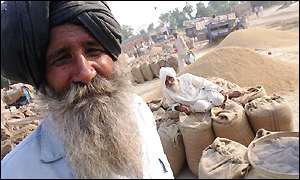 An interesting development is an independent study conducted by a group called the “Movement Against State Repression,” a Chandigarh based non-profit organization which seems to be working with patwaris in Sangrur.
An interesting development is an independent study conducted by a group called the “Movement Against State Repression,” a Chandigarh based non-profit organization which seems to be working with patwaris in Sangrur.
Inderjit Singh Jaijee, convenor of the Movement Against State Repression (MASR), has said patwaris in Sangrur district have collected information with regard to the cases of suicide by farmers. [link]
This is a positive development because the findings of the PAU can now be measured against the findings of MASR, at least in Sangrur, to ensure the truth of the figures. This is especially important because PAU is known to heavily push farmers to use pesticides which are harmful to the land, the farmers, and one factor of the recent agricultural decline of Punjab.
UPDATE: Although this post is over 5 months old, I thought I would give an update on the current case. It seems The Herald, a Catholic newspaper in Malaysia, has filed a lawsuit against the Malaysian government’s attempt to ban the usage of the word “Allah” by non-Muslims. The Malaysian Gurdwara Council (is this a real organization or a one-man show, can any of our Malaysian readers fill us in as I couldn’t find any information) has added their name to the lawsuit. Again, I revisit the question, can any one religous community claim a monopoly on its religious vocabulary? How about iconography?
———————————————————————————-
The Sikhs have a long, proud, and distinguished history in Malaysia. While Sikh traders began arriving in South East Asia, during the Mughal period, the Sikh numbers markedly increased under British imperialism.  Sikhs were often settled throughout the colonies as police men and later took a lead role in the transportation industry. Their presence and connection to Punjab has been strong throughout the past and the Khalsa Diwan Malaysia took an active role in ratifying and creating the Panthic Sikh Rehat Maryada during the early years of the 20th century. The Sikh Naujawan Sabha Malaysia remains a leading example of a diasporic Sikh organization.
Sikhs were often settled throughout the colonies as police men and later took a lead role in the transportation industry. Their presence and connection to Punjab has been strong throughout the past and the Khalsa Diwan Malaysia took an active role in ratifying and creating the Panthic Sikh Rehat Maryada during the early years of the 20th century. The Sikh Naujawan Sabha Malaysia remains a leading example of a diasporic Sikh organization.
Despite the Sikhs’ prominent standing in Malaysian society and the relatively secular nature of Malaysian Islam, it is of some note that the government recently moved to have the words “Allah” (God), “Kaabah” (Worship center at Mecca), and “Solat” (prayer) banned from non-Muslim literature and speech.
While I would guess Christian evangelism (Christians in Punjab love to call Jesus ‘Satguru’ and have ‘kirtans’ in his praise) was the main target of such legislation or appeasement towards certain political parties and groups, I am not sure what will be the impact for Sikhs due to our community’s unique lingual affinities with Islam.
It was reported this week that a Court in Belgium has overturned a ban that had been established for five Sikh students wearing Patkas. This case began in May 2005, when these Sikh students were banned from attending KTA Domein Speelhof school in Belgium due to the implementation of a new uniform rule banning head coverings.
The court said that the ban on the religious head covering was a violation of the Sikh students’ right to manifest their religion under article 9 of the European Convention on Human Rights, of which Belgium is a signatory.
In a judgment handed down today, Judge Madam H. Coenen said that by excluding young people because of their religious beliefs the Domein Speelhof school in St Truiden had violated their right to practice their faith.
United Sikhs took up this case and are applauded for their great work.
The news comes at a time when our community is faced with many cases of injustice for practicing our faith as Sikhs. This is a positive step and shows that the fight for our rights as Sikhs is not a lost battle. It will take time, but we are progressing toward educating people who we are as a community. There are many more cases to be fought, but we will persevere.
Sorry for my long absence. Expect an explanation post very soon.
Although there is more current news, there are two past due topics that need to be discussed in The Langar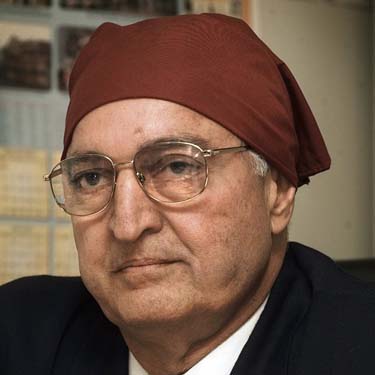 Hall. I begin with the first.
Hall. I begin with the first.
Now while Mack-10’s lyrics in the title of this post may not be completely appropriate, I use them to highlight a possible historic event in the Sikh community in Canada and beyond.
For those of us that grew up in the states, the Dasmesh Darbar of Surrey and the Guru Nanak Sikh Temple of Surrey entered our popular imagination in 1998 when Sikhdom was shaken by the inane “tables and chairs” controversy. A local Surrey conflict soon ballooned throughout the world and even saw violence at a number of different Gurdwaras in North America and Europe. A conflict, which most did not understand, divided local communities and caused rifts that still fester within the Sikh community today.
The worst-affected area was where the controversy initially began – Surrey, Canada. A new vocabulary entered into the language of Sikh-British Columbians: “fundies” verses “moderates.” A generation of Canadian youth saw rishtas broken and dinner conversations centered around “uthay ja thalay” (“up” or “down”).
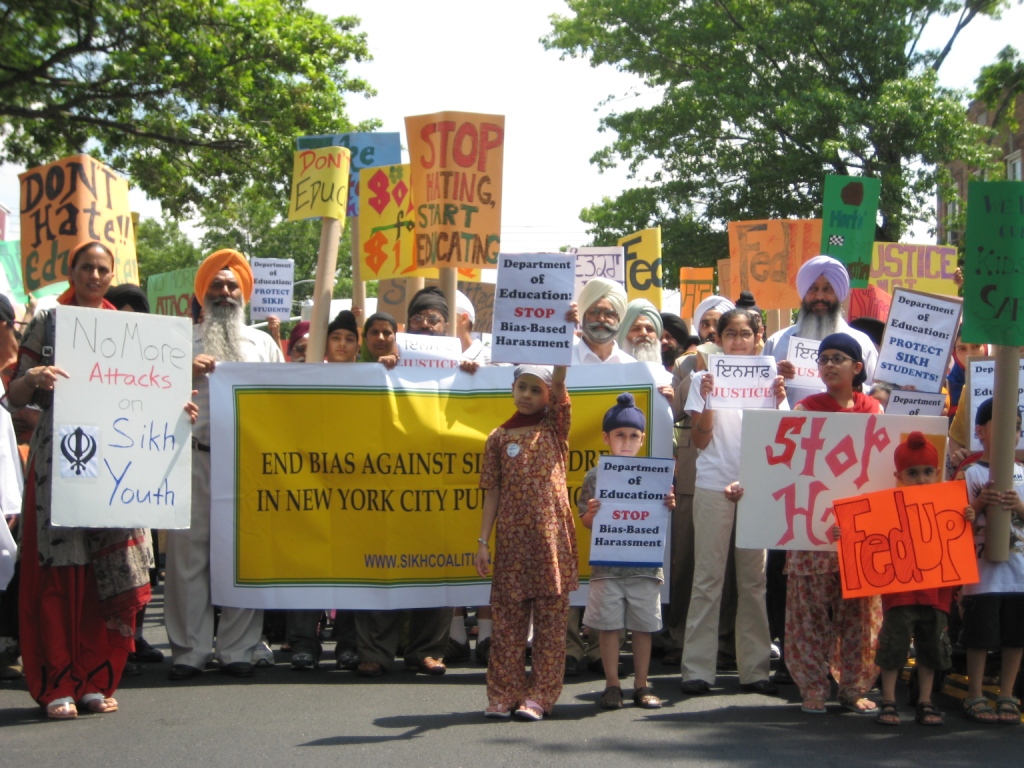 I’ve mentioned before how much I enjoy belonging to such a pro-active community. I don’t know whether it’s the Punjabi, the Sikh, or some combination of the two influences that makes people speak out, but whatever it is, I love it.
I’ve mentioned before how much I enjoy belonging to such a pro-active community. I don’t know whether it’s the Punjabi, the Sikh, or some combination of the two influences that makes people speak out, but whatever it is, I love it.
This picture, I think, portrays why. It speaks volumes. Hundreds of men and women of every age group walked together and made their voices heard in Richmond Hill today.
“Don’t Hate, Educate” and “Fed Up” (says the chotu in the front row on the right).
The girl in the front, center stole a piece of my heart too.
From the Sikh Coalition:
REMINDER– If you’re in the New York area, take the morning off work/school on Monday and join the Sikh Coalition in a march to end harassment against Sikh students in public schools:
When: Monday, June 30th, 11:00AM
Where: Meet at Sikh Cultural Society: 95-30 118th Street or Gurdwara Baba Makhan Shah Labana: 113-01 101st Ave.
Why: 1) Sikh students have a right to attend school without fear of harassment for being Sikh, and 2) you can help future students have a better experience in school than you, your siblings, or your friends may have had!
————————————————————————————–
The violence against Sikhs in New York that the Sikh Coalition tracks, and reports is a representation/reflection of the violence that young Sikh students undergo in many areas of the US. In areas where we don’t hear about such violence, it’s not because it doesn’t occur, but because organizations like the Coalition don’t exist to track, report and respond to the violence.  Ideally, we should all be able to respond to the needs of our local community, and I hope that we are building the capacity to do so in the near future. In the New York area, the Coalition is responding.
Ideally, we should all be able to respond to the needs of our local community, and I hope that we are building the capacity to do so in the near future. In the New York area, the Coalition is responding.
In the latest of a spate of attacks on Sikh students in New York, 12 year old Gurprit Kaur had part of her braid cut off and thrown in the trash. This occurred about a little over a year after another student’s hair was forcibly cut in the New York area in May of 2007. In response to the series of attacks on Sikh students in the New York (especially Richmond Hill) area, in the face of inaction by authorities after the group’s troubling findings on harassment in the school system, the Coalition is organizing a march on Richmond Hill High School. [Click on flyer for details.]
A blogger recently mentioned that many of us switch back and forth between English and Punjabi in conversations, and how it’s sometimes more comfortable to speak Punjabi. Have you thought about how your mental frame of reference shifts when you switch languages? Do you think this affects your personality? A recent study seems to think so…
Bicultural bilingual individuals have incorporated two cultures within themselves and speak the languages of those cultures. When cued by a particular language, these individuals activate distinct sets of culture-specific concepts, or mental frames, which include aspects of their identities. Three studies show that language-triggered frame switching (i.e., switching from one set of mental frames to another) occurs only with biculturals, not with bilinguals who are not bicultural. The studies uncover frame switching at the within-individual level, and they include both qualitative and experimental evidence. They also provide a methodology to identify the relative activation strength of specific mental frames in different languages. [link]
Researchers found that women classified themselves and others as more assertive when they spoke Spanish than when they spoke English. The study was based partly on women’s reactions to television commercials shown in English and Spanish.
One part of the study got the volunteers to watch TV advertisements showing women in different scenarios. The participants initially saw the ads in one language – English or Spanish – and then six months later in the other… “In the Spanish-language sessions, informants perceived females as more self-sufficient and extroverted,” they say… For example, one person saw the main character in the Spanish version of a commercial as a risk-taking, independent woman, but as hopeless, lonely, and confused in the English version. [link]
I haven’t read this paper yet so I don’t know the entire methodology, but from the TV-ad experiment, I wonder if the perceived assertiveness is a reflection of the level of comfort within the culture that the individual was responding to. If you’ve noticed a shift in mental frames when you switch from English to Punjabi (or French, or whatever else you speak), how does the shift in mental frame affect your personality?
SCORE has already come under scrutiny here in The Langar Hall, and I don’t wish to scrutinize the entire organization further. But their list of honorees from the 2008 Heritage Dinner does deserve some attention. This year, the following individuals were honored:
1. Sandeep Singh Caberwal, a Sikh entrepreneur in Silicon Valley and a model, wears a turban, has a beard and was chosen by designer Kenneth Cole in its recent fashion campaign
2. Ms. Tami Yeager and Preetmohan Singh for their film documentary “A Dream in Doubt,” which explores the real life story of Rana Singh Sodhi’s family, whose brother was murdered as the first hate crime victim in AZ in the 9/11 aftermath
3. Darshpreet Singh, a recent graduate of Trinity University in San Antonio, Texas. was co-captain of the Men’s Basketball team and fan favorite, and believed to be the only turbaned Sikh to play in a National college basketball game
4. Dr. Jagjit Singh Khalsa is the Chief of Medical Consequences of Drug Abuse at the US National Institutes of Health
5. Gurvendra Singh Suri, founder & CEO Optimal Solutions Integration, Inc., a successful technology consulting Company in Dallas, TX
6. Raghbir Singh Subhanpur, business owner from New York and President of New York Shiromani Akali Dal was honored with Community Service award
7. Surinder Singh Chawla, Nassau County Human Rights Commissioner, was honored for Social Activism and Service
8. Ro Khanna, an Indian American political activist from California was also honored for his role in supporting Sikh issues. [link]
Readers, what strikes you as odd about this list? . . . The only woman recognized is American. How is it possible that no Sikh women made any noteworthy contributions to the Sikh or American community in the past year? (There seems to be an attempt to recognize contributions to both Sikh and American, non-Sikh communities.) Let me tell you- it’s not.
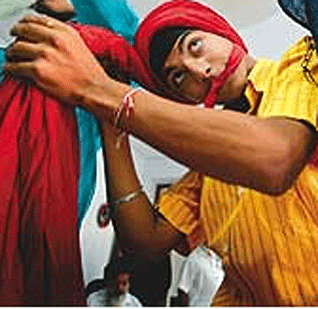 Could the community’s recent rallying in response to hate crimes have similar results (though in smaller proportions) as was seen after Operation Bluestar of people re-committing to their faith?
Could the community’s recent rallying in response to hate crimes have similar results (though in smaller proportions) as was seen after Operation Bluestar of people re-committing to their faith?
Many Sikhs today, unfortunately, cut their hair at some time during their adolescence. This is seen amongst Sikhs who are isolated in communities that have little or no exposure to Sikhs (or sometimes anything outside of that particular community) but also in communities with large numbers of Sikhs.
It seems that at least in New Jersey, the increasing number of Sikhs along with recent media exposure is alleviating at least one of the reasons that kids decide not to keep the Sikh roop.
Despite the recent brutal harassment of a high schooler in New Jersey which made international (Indian) news, some Sikhs in Jersey feel that awareness of Sikhs is growing. The media campaign after the incident has also probably contributed to increasing awareness in the area.
 For a place that makes money off turban-wearing and multicultural disney characters, it seems a little ironic that a turban-wearing employee of Walt Disney would be fired for not having the “Disney look.” Uhh what?
For a place that makes money off turban-wearing and multicultural disney characters, it seems a little ironic that a turban-wearing employee of Walt Disney would be fired for not having the “Disney look.” Uhh what?
This story has been getting a lot of press lately (so for the two of you who haven’t heard) Sukhbir Channa applied for a job (as a trumpet player) with Disney in September 2006 but was told that he couldn’t be hired unless he removed his religiously-mandated turban. He was told that he did not conform with Disney’s grooming and dress requirements known as the “Disney Look.” (Okay, but Aladdin does?) Our friend over at SikhSwim makes a good point,
On my last visit to Disney World, little kids, when they saw me, would say, “Hey look, it’s Aladdin!” So I think Disney’s position has no basis. I think Sikhs have the “Disney look” if average people confuse us for some of the popular Disney characters! [link]
SALDEF has stepped in to help Channa with his lawsuit,
“Disney’s position is fundamentally un-American because it forces Sikhs and also observant Jews and Muslims to sacrifice religious freedom in order to pursue their career goals,” said SALDEF Chairman Manjit Singh. “It is also hypocritical for Disney to make millions of dollars promoting cartoon characters that wear turbans and simultaneously reject the right of an employee to wear a turban in accordance with his faith.” [link]
Having earned a bachelor’s degree in music, Channa just completed a nine-month U.S. tour with the Broadway show Annie. We’ll update you as soon as we hear more about this story. In the meantime, what are your thoughts on this and am I the only one impressed that we know a Sikh trumpeter?!
 72 year old Balwant (“Bobby“) Singh Grewal is walking 500 miles (800 km) from the Scottish Parliament Building in Edinburgh to the House of Parliament in London in five weeks. He began on June 5th and is scheduled to finish on July 9th. He is raising 100 million pounds for cancer research. (If you can’t tell by the bolded format, I’m rather impressed by this feat.)
72 year old Balwant (“Bobby“) Singh Grewal is walking 500 miles (800 km) from the Scottish Parliament Building in Edinburgh to the House of Parliament in London in five weeks. He began on June 5th and is scheduled to finish on July 9th. He is raising 100 million pounds for cancer research. (If you can’t tell by the bolded format, I’m rather impressed by this feat.)
Grewal is undertaking the walk to raise one million pounds for research into bowel cancer and other bowel diseases at St Mark’s Hospital, Harrow, a hospital unique in the U.K. [link]
This isn’t the first time Bobby Grewal has walked to raise large sums of money for medical research.
In 2001, he ran the London Marathon in just over five hours, and in 2004-5 (aged 68), he completed a walk covering 2,500 miles across India from the North-West frontier to the deep South…The walk raised 100,000 pounds for research into cancer and AIDS. [link]
Do you think Bobby Grewal is in the same class as the legendary Fauja Singh?
So this week, I blogged about two unfortunate murders in the community. Maybe as a release, maybe just to cheer everyone up for the weekend, I am returning to my Friday lite post.
We’ve seen the talent in Britain, with Suleman Mirza and Madhu Singh together as Signature. And as brilliant as they may be, I have a partiality towards Sardool Sikandar.
Sardool Sikandar is often known more for his marriage to the beautiful Amar Noorie than for his own singing talent. However, hits like Tor Punjaban Di and Mittran Nu Margiya still remain some of my favorites.
Here is a recording from the mid 1980s at Doordarshan’s Amritsar studios. It was this performance that launched the Sufiana classically-trained Sikandar’s career. Here he does various impressions of Mohammad Siddique and Ranjit Kaur’s classic “Aagay Roadways di lari, na koi sheesha na koi bari….”

While I am partial to his amazing Kuldip Manak and Yamla Jatt, do you have a favorite?
